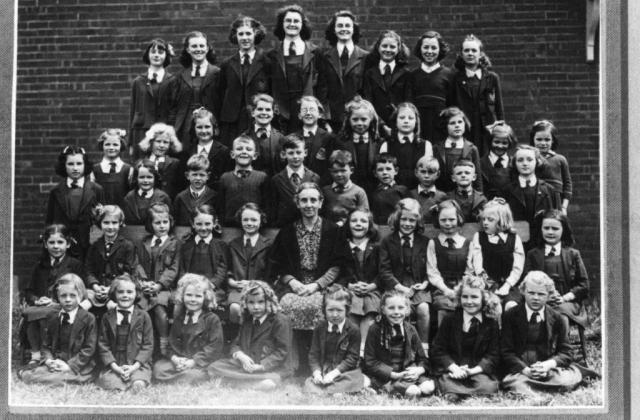As well as the ‘Cathedral Schools’, numerous privately run colleges and finishing schools operated at varying times throughout West Hobart.
One such institution was Queen’s College, which was originally based in ‘Minallo’, a grand old house located in Minallo Avenue.
The principal of the school was Miss Pearl Walter, who was assisted by two female teachers. At the entrance to the carriage drive off Pine Street were two blue painted wooden gates, with a smaller gate for pedestrians. Large gum trees and pines lined the driveway, which swept around a corner and made a circuit in front of “Minallo”.
Three spinster ladies, the Misses Alderton, were caretakers of the grounds and many rooms of “Minallo”, not used by Queen’s College.
The College was later moved in 1941 to a hall in Arthur Street, but closed down in 1943 on the retirement of Miss Walter.

Photo of pupils 1941 or 1942 (Bill Stennard, 3rd row 4th from left)
http://adb.anu.edu.au/biography/stephens-arthur-augustus-8643
At 19 Stephens established the New Town Classical and Commercial School which, within four years, merged with Officer College, Hobart. In July 1893 he opened Queen’s College in Hobart, its main object being to prepare pupils for university examinations, although special classes were also provided in commercial subjects. Such was Stephens’ character that, when he left Officer College, its best students followed him.
Queen’s was to be a school over which he ruled absolutely, free from the controls of school councils and committees. Although Stephens was a practising Anglican, his school had no denominational affiliation or external assistance. By 1895 he had made Queen’s largely co-educational: while there were ‘mixed-classes’, there was strict segregation at other times, with separate playgrounds for boys and girls. To Stephens, the co-educational experiment had been a very satisfactory innovation. Nevertheless, as Queen’s grew in size and reputation, boys came to predominate in number and in 1908 the Girls’ Department was discontinued.
Academic excellence was the hallmark of Queen’s. The school motto, Palme non sine pulvere(No reward without hard work), summed up Stephens’ approach to study. ‘He was indefatigable himself, but boys soon learnt that they had more to do than watch him work. He had a wonderful power of impressing upon others a portion at least of his own zeal and enthusiasm.’ Stephens’ wisdom, liberality and understanding made Queen’s the most notable school in Tasmania over a period of nineteen and a half years. Loyalty was another element which he had engendered. Roy Bridges, an ex-student, wrote of Stephens that he was ‘good-looking, dark-haired, dark-moustached, fresh-faced and kind of eyes; black of tail coat; grey of trousers, and white of waistcoat and starched linen. From the moment he smiled, offered me his hand and called me by my Christian name, I worshipped Arthur Stephens’.
Around 1911 he began to feel the administrative burdens and saw value in the backing of an institution like the Church of England. Plagued by continued ill health, Stephens was to allow the amalgamation in 1912 of his far larger school with The Hutchins School, of which he became vice-master. By late 1913 his health had so deteriorated that he was persuaded to take three months leave. Stephens died at New Town of pernicious anaemia on 14 May 1914, survived by his wife, Ida Ethel Marion, née Steele, whom he had married at Forcett on 28 June 1905, and two small children. Five hundred people attended his funeral at St John’s Anglican Church, New Town, and Queen’s old boys carried the coffin to the churchyard cemetery.
